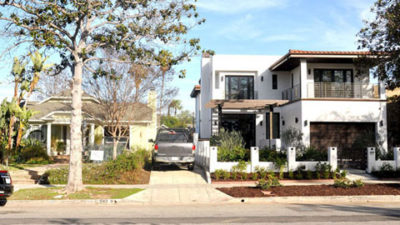Mansionization encroaches on area’s historic fabric

HOUSES on the 500 block of N. Arden.
This is a memo of gratitude to the city of Los Angeles. In late March 2015, an Interim Control Ordinance (ICO) went into effect in 15 residential neighborhoods. Five of them are in Council District 4 and one, Larchmont Heights, is an area of small bungalows north of Beverly. I live in Larchmont Heights.
This ICO is a set of rules, passed by the City Council, that impose temporary restrictions on developers and others who want to either tear down existing houses or pile on square footage to existing houses, yielding results that are out of scale with lot sizes and surrounding neighborhoods.
Adoption of the ICO is a reaction to the legitimate fear of what’s known throughout the city as “mansionization,” a word as difficult to say as its meaning is to endure for most who live in neighborhoods unprotected by other means, such as an Historic Preservation Overlay Zone (HPOZ).
But most people in the city know what this unwieldy word means: huge houses on small lots.
The rules vary by neighborhood. For Larchmont Heights and a few others, the ICO prohibits any building permits for plans that exceed 120 percent of the prior or existing structure. (Exceptions, especially for existing homeowners, are spelled out.)
This is where my gratitude comes in. Last month, I wrote about the death of our much-missed neighbor. It took awhile to settle her estate, but by the time developers (“flippers,” in common parlance) bought her house, the ICO was in effect. The house next door was 1,250 square feet; its remodel is about 1,500.
Until we learned about the ICO, the sale next door put us into a tailspin. Why?
The most obvious answer is privacy. My back garden is a private space, a refuge; so are the two small buildings in which I work. The etching press is in the garage; the library and desk are in a 100-square-foot cottage. Both are contemporaneous with the 1921 house. My lot and hers are 5,000 square feet. It’s already tight back here.
But these are personal reasons to fear a looming second story next door; other reasons have to do with mostly hidden dimensions within the human experience. Most of us are rarely aware of them.
We don’t all relate to the same things, nor do we see the same things. Much of it is cultural, but our transactions with our environment are always deeply personal. I won’t see what you see; there seems to be persuasive evidence that what we do “see” around us depends on how we think about things. Life is lived, after all, from the inside out.
People who are attracted to the community fabric of our local historic neighborhoods— their scale, their pedestrian-friendly streets, and our shared village center with diagonal parking—are likely to have this environmental proportion embedded in their experience. It may relate to childhood, or to the loved landscape of an equally loved grandmother. It’s a human scale. It fits the human body, which throughout the world has for millennia been the measurement by which we have lived.
To paraphrase the landscape historian John Stilgoe, a cityscape, a neighborhood boundary, is what city planners and geographers say it is—a discrete area. But it may be something else too, something that defies price per square foot and building surveys. It may be a prism through which we see our world.
The ICO, described by many as a “time-out” for inappropriate building, will expire in early 2017. City planners are at work revising the Baseline Mansionization Ordinance, citywide guidelines that may adequately protect neighborhoods. The amendments will go before the city Planning Commission on May 12.
By Paula Panich
Category: Real Estate


